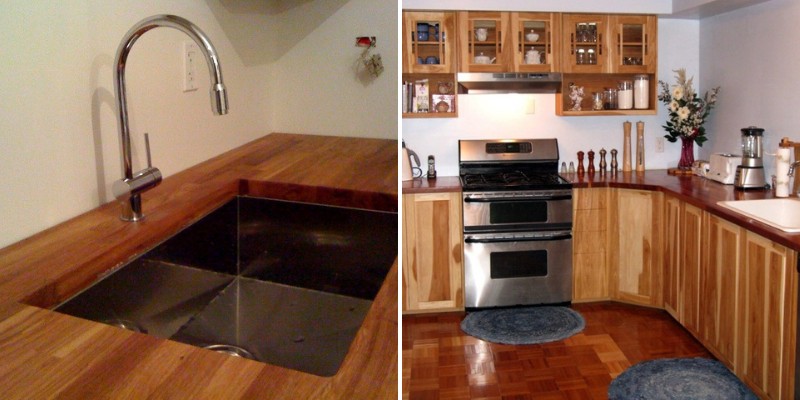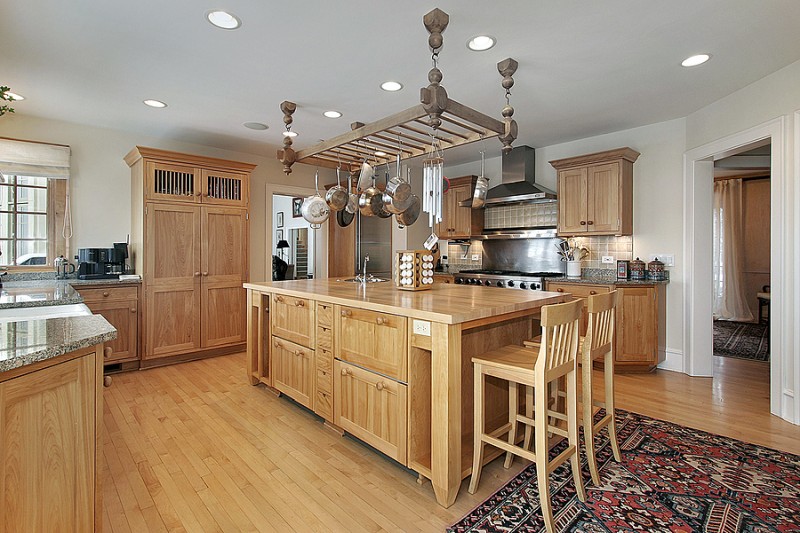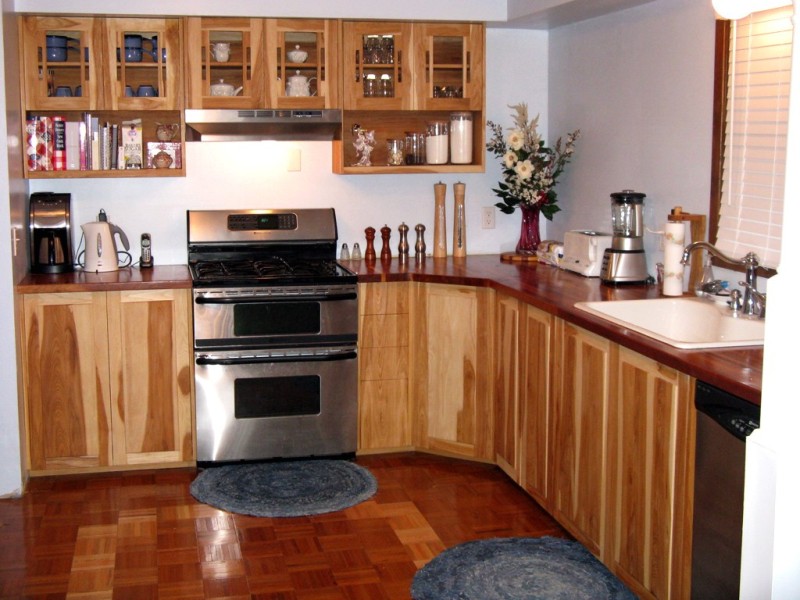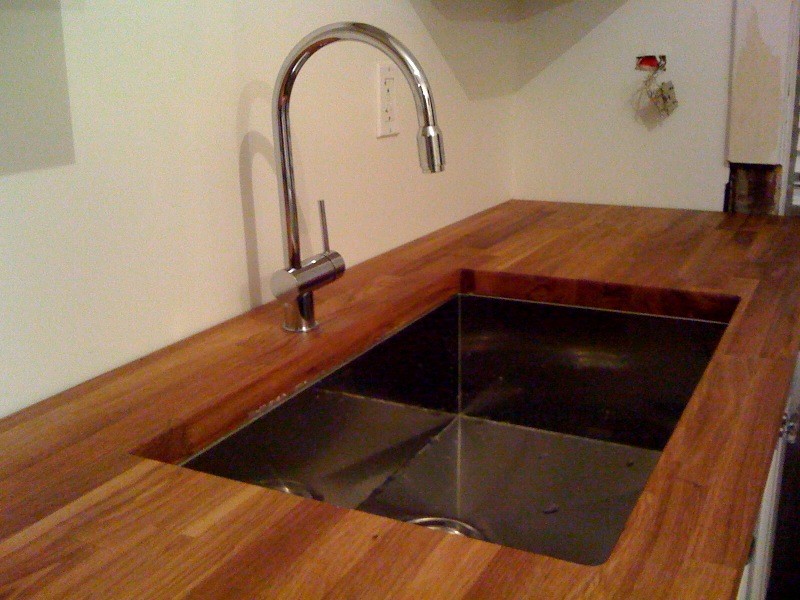If you were asked to guess where the concept of butcher block originated, would you have said China? Historians say that this material’s origins harken back to prehistoric times in Asia when hunters culled thick rounds of tree trunk for butchering and food preparation.

Over time, tree trunk slabs became the preferred surface for butchers because hatchets, knives and other cutting tools were receptive to powerful cuts.
Centuries passed and wood slabs became longer, wider and more precisely shaped thanks to the invention of electric saws.
Cooks and butchers adopted oiling practices that not only prolonged the longevity of these counters but the procedure made meat preparation safer and cleaner because blood and liquids couldn’t be absorbed as easily into their countertops.
Today’s butcher block counter tops are modern takes on these once-primitive surfaces. They are beloved by homeowners and interior decorators craving a warmer, earthier kitchen design, but with this vintage appearance comes more than the usual amount of maintenance.
Nevertheless, butcher block remains a popular pick as evidenced by the long list of woods you can now find on the market when shopping for these countertops.
What are butcher block countertops?
Called “a warm alternative to cool stone,” House and Garden writer Kim Hildenbrand refers to butcher block countertops as “character-rich woods” that homeowners often pick for islands and eating areas.

Describing the process of compositing wood to create these surfaces, she says that authentic butcher block is “made from strips of wood bonded together,” creating the unique patterns that distinguish this design from other wood types.
Let’s now discuss some Pros and Cons of butcher block wood used in countertops:
Advantages of butcher block countertops
- -It’s one of the trendiest materials on the market.
- -Costs only between $20 and $60 per square foot (material cost).
- -Affordable compared to higher-end natural stone material.
- -Makes an easy DIY project for folks with tools and skills.
- -It’s easier to cut butcher block sections than it is to cut stone.
- -No worries about dropping butcher block and shattering it.
- -Naturally antibacterial once sealants are applied.
- -Ordinary household cleaners (especially vinegar) make for quick cleanups.
- -Stains may be removed using table salt and lemon juice.
- -The number and types of woods used to make butcher block are vast.
- -You can choose between several types of grains in addition to woods.
- -May last 20 years (the same as granite) if properly cared for.
- -Available in bamboo, a star in today’s sustainable wood family.
Disadvantages of butcher block countertops
- -This material is ultra-sensitive to liquid, explains Bob Vila.
- -Wood is more susceptible to mold, mildew, germs and warping.
- -Most woods must be sealed immediately after installation.
- -Soft wood butcher block countertops could require regular re-sealing.
- -Experts recommend re-sanding and re-oiling butcher block every 10 years.
- -Spills could leave permanent stains if not cleaned up ASAP.
- -This material is especially vulnerable to scratches and dents.
- -Chopping and cutting on these countertops is to be avoided.
- -Butcher block expands and contracts in reaction to temperature fluctuations.
Types of Butcher Block Countertops
The variety of butcher block countertops on today’s market is breathtaking, as evidenced by the length of this list.

Source: https://www.flickr.com/photos/23774191@N03/3424515629
Here are some types that you can buy:
- Maple: The mother lode of butcher block counter material is found within the maple wood family, yet this wood type is relatively inexpensive. It naturally darkens over time which adds character.
- Acacia: If you crave distinct grain styling, acacia wood butcher block countertops belong in your kitchen. There are 1,000 species of this type of tree, so expect plenty of variety when making your wood choice.
- Alder: Want the look of pine but not the soft texture and vulnerabilities? Alderwood butcher block makes a harder substitute for rustic and traditional kitchens.
- Ash: If warm tones don’t work for your kitchen, this grey-brown wood cools things down and it’s a very resilient type of butcher block.
- Bamboo: Affordable, functional and eminently sustainable, this hardwood comes in myriad grains and you get to help save the environment.
- Beech: Considered one of the hardest natural woods on the market, beech butcher block is both tough and durable.
- Cherry: Install a cherry butcher block countertop in a light-colored kitchen and expect compliments since this dark wood is a stand-out.
- Chestnut: Find this butcher block countertop material amid reclaimed woods that deliver an authentic rustic look that has no match.
- Hickory: It’s been around since the Ice Age say geologists, so hickory butcher block counters get A+ reviews for beauty, toughness and longevity.
- Mahogany: Yet another soft wood, pick it anyway if you seek a luxurious look and have no plans to literally chop foods on the countertop surface.
- Pine: Because it’s so soft, pine isn’t the sturdiest countertop material, but knotted pine butcher block wins the hearts of homeowners who love the “cabin” look.
- Poplar: Finely-grained and sporting lighter colors, this is the countertop to choose if your personal style could best be described as IKEA or minimalist.
- Red oak: Homeowners choose this butcher block wood for its distinct reddish-brown hue and its ability to coordinate so elegantly with all kitchen décor looks.
- Sapele: This trendy, warm, rich butcher block countertop wood can be hard to find but it’s worth the search.
- Teak: Teak butcher block is naturally waterproof due to this wood’s high natural oil content. It’s hard to cut because the natural silica embedded in the grain makes it extremely dense, but since it’s also fire- and acid-resistant, what’s not to love?
- Walnut: Dark, dense and tight-grained, walnut butcher block is beloved for its strength, color range and grain.
- Wenge: This “coveted hardwood” is dark, dramatic and pricey, but if you’re seeking a butcher block option you won’t see often, put it on your short list.
- White oak: An ideal option for kitchens that are uber-modern or those with an eclectic theme, white oak butcher block countertops have a distinct Scandinavian vibe.
- Zebrawood: This is sturdy, cream-colored wood is imprinted with a zebra-look grain, so if you seek an out-of-the ordinary countertop pattern, zebrawood has no equal.
How much do butcher block countertops cost?
There is no easy answer to this question because, say experts at HomeAdvisor.com, “wood prices vary by season, year and tree species depending on demand and availability.”

Source: https://www.flickr.com/photos/qmnonic/4271672203
Countertop size must also be factored into the equation when determining material and labor costs. That stated, these general figures can give you a ballpark estimate of how much of your budget to allocate if you’ve decided that nothing but butcher block countertops will do for your kitchen.
- -The average cost of wood butcher block countertops is $3,500 for materials and installation.
- -Per square foot cost can run between $40 and $100 (material + labor).
- -For a kitchen requiring 50 square feet of countertop, estimate spending between $2,000 and $5,000.
- -Pick out exotic hardwoods and expect to spend $200 per square foot (over $15,000)
- -You could fork out between $1,000 and $7,000 to buy enough material to cover 100 square feet
- -Labor costs could set you back between $500 and $3,000 per 100 square foot.
- -Raw, unfinished butcher block runs between $30 and $75 per square foot
- -The same amount of finished butcher can cost between $50 and $125
- -The cost of supplies to complete a butcher block countertop project is likely to total between $100 and $250 for glue, sealants, caulking, fasteners and cleaning supplies.
- -If you don’t have specialty tools to undertake this job yourself, add between $30 and $100 to rent a belt sander, miter saw, electric planer and pneumatic nailer.
- -Experts estimate the job of acquiring materials, amassing equipment, prep, set-up and clean-up at approximately 10 hours in the hands of a skilled professional.
- -Add an edge to the butcher block you choose increases the material cost, regardless of whether that edge style is bull nose, radius or straight.
- -If you’re on the fence about whether butcher block woods are too expensive, keep in mind the fact that granite runs between $80 and $250 per square foot and you probably won’t wind up with a look that’s as warmly classic and inviting.
Can you seal butcher block countertops?
Not only can you seal butcher block countertops, but in many cases, applying a bar top epoxy sealer is the only way to be absolutely sure that your kitchen surfaces stay sanitized.
Regular cleaning keeps them in good shape, but due to the porous nature of woods on our list, cleaning, oiling and sealing aren’t suggestions; they’re mandatory.
How To care for butcher block countertops
The care and feeding of this type of wood, regardless of the tree species, can be time consuming but what regular kitchen chore isn’t?
Oil unfinished butcher block monthly for the first year following its installation and at least twice a year thereafter.
Neglect this routine and your countertop could be more vulnerable to absorbing food stains, harboring pathogens, separating or splintering.
Get as creative as you like when it comes to oils. Good candidates are food-grade mineral oil, pure tung oil, raw linseed oil, walnut oil, almond oil and coconut oil.
Lacquered or sealed countertops don’t have to be oiled but you may wish to consider re-staining them every 3 to 5 years, depending upon wear and tear.
By the way, butcher block countertops, when compared to stone, stainless steel, tiles and other non-porous materials, are considered to be the highest maintenance countertops on the market.
The 6 biggest mistakes DIYers make when installing butcher block countertops
1) Deciding that they don’t need specialty tools in order to prepare and install the countertops.
2) Not paying attention to which wood grain best matches decor. There are three types: decorative face grain (also called plank grain), edge grain (a simpler pattern) and end grain, the most authentic and easily identified by its unique checkerboard appearance.
3) Giving the project short shrift when estimating the amount of time it will take to do the job. Expect to spend at least 2 full days on the project – maybe more if you run into problems.
4) Sustaining an injury during the process of placing and adhering butcher block countertops is more frequent than you may imagine. Due to the size, thickness and weight of these wood countertops, take extra precautions and don’t rush.
5) Choosing a thickness that won’t stand up to your lifestyle. Butcher block countertops come in thicknesses that range from 2- to 12-inches in stark contrast to other countertop materials that run only between ¾-inch to 6-inches thick.
6) The biggest mistake of all? Improper cutting and fitting. Make one small mistake and you will have to re-order the butcher block material and start all over again. Didn’t your dad tell you to measure twice and cut once? Keep those wise words in mind!
Resources
https://wood-countertop.glumber.com/the-history-of-butcher-blocks/
https://www.hgtv.com/design/remodel/kitchen-remodel/butcher-block-and-wood-countertops
https://www.bobvila.com/articles/butcher-block-countertop-pros-and-cons/
https://spacify.com/blogs/interior/16-of-the-best-butcher-block-countertops
https://acaciawoodusa.com/pages/what-is-acacia-wood/
https://www.glumber.com/wood-countertops-design-guide/wood-countertop-species/burmese-teak/
https://www.homeadvisor.com/cost/cabinets-and-countertops/butcher-block/
Related Posts
- 11 Ways to Get Rid of Cooking Smells in a Small Apartment or House
- Comparison of Corian Countertops vs Laminate for Kitchens
- All About Fragranite Kitchen Sinks With Pros & Cons
- Comparison of Granite Composite Sink vs Stainless Steel
- How Much Does it Cost to Paint Kitchen Cabinets?
- What Color Granite Goes With Maple Wood Kitchen Cabinets?
Leave a Reply